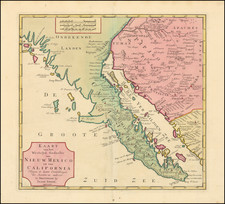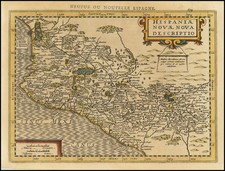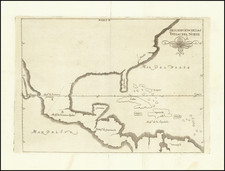A fine and detailed original early 19th-century watercolor depicting three Aztec deities. The depictions are based on the Codex Telleriano Remensis. The watercolor drawing was created by Capt. William H. Shippard, a British artist who was also a pioneer researcher of early Mexican civilizations. Each of the three figures has identifying annotations in Shippard's distinctive handwriting:
Probably dressed in skin of Felis Pardalis the Ocelot with colour put on it.
For Ocelot see Plate 16, page 206, vol. 2. Mammalia Sir. W. Jardine's Naturalists Library.
- Tezcatlipoca. Devil. On the Sign of Seven Cipactli. Tezcatlipoca? Xolotle? Smoking Mirror in animal guise.
- Apparently early commentators mistook this deity as representing "the devil" tempting Eve to sin.
- Iztapaltotec. Iztapoltepec. Sword or Fear. Perhaps the same as Thipetotec elsewhere discribed and dressed in Human Skin
- Itztapaltotec represents an aspect of the fertility deity Xipe Totec... In this guise he appears as a human figure combined with a gigantic knife, which is worn as a kind of helmet headdress with an opening through which a human head peers out.... The figure wears a flayed human skin over his red body - Quiñones Keber.
- Xiuhteuchtli [i.e. Xiuhtēcuhtli] Izpactli? God of Fire. Also known as the Turquoise Lord.
- ... the ancient fire god Xiuhtecuhtli... He bears the usual hallmarks of this deity: a thin, horizontal black line at eye level, the turquoise nose rod, a stepped chest ornament, the mosaic headdress of Aztec rulers that alludes to the lord (tecuhtlí) component of his name, and the fire serpent (xiuhcoatl) disguise behind his head... Also known as a god of war, he holds an arrow projectile (atlatl) in one hand and a snake staff in the other - Quiñones Keber.
The sheet is dated by Shippard:
2 Edwardes Place
Kensington 9 May 1844
William Henry Shippard's Mexican Paintings
William H. Shippard (1803-1865) was a pioneering 19th-century British museologist - an unsung progenitor of modern-day museum anthropology. While he is chiefly remembered as a friend of George Catlin, Shippard's profound interest in the ancient civilizations of Mexico connects him with a cohort of British contemporaries that include Lord Kingsborough and the showman William Bullock. Shippard's fascination with Mesoamerica propelled him to amass a significant collection of visual material derived from Aztec codices which he copied himself. A figure of some intrigue and scholarly ambition, Shippard endeavored to establish the Museum of Mankind in London, which seems to have evolved from his deep interest in early Mexican cultures. Although the museum did not come to fruition, Shippard's original artwork, mainly pen and ink drawings enriched with vibrant hand coloring, based on Mexican codices held in European libraries and collections, remains a valuable historical source, particularly for understanding the allure of Mexican antiquity within early 19th-century British collecting circles.
Capt. William H. Shippard, a friend of George Catlin and an avid watercolorist and museologist, was also a pioneering British Mesoamericanist. Shippard appears in British newspaper notices from the 1840s as a London-based lecturer who spoke about Native Americans and Mexican antiquities. We know he was a friend of George Catlin, and that he was involved in attempts to organize early London museum exhibitions of Mexican antiquities. In the latter efforts Shippard would seem to coincide with a group of like minded prominent English collectors interested in Mexican topics active during the 1820s and 1830s, including Lord Kingsborough and the bibliomaniac Sir Thomas Phillipps, among others. He seems to have been an armchair anthropologist and would-be museum founder, whose ambitious ideas for a London-based museum never got off the ground - at least not beyond the prospectus-printing stage. Certain aspects of Shippard's career are akin to William Bullock, the showman and connoisseur of Mexican antiquities who actually did travel to Mexico. Bullock published a notable book about his Mexican travels, and achieved a level of recognition in his day as the empresario of London's Egyptian Hall, wherein he thrilled large London audiences with his elaborate exhibitions of exotica, including Mexican items.









![[Florida Indians / Hermaphrodites] Hermaphroditorum officia. XVII.](https://storage.googleapis.com/raremaps/img/small/97966.jpg)



![Amer. Sep. No. 71. Partie Du Mexique et de Guatemala [Oaxaca, Tabasco, Chiapa, Verapaz]](https://storage.googleapis.com/raremaps/img/small/96583.jpg)
![(Mexican Antiquities - Photography) [Western Facade of the Fourth Palace, Mitla, Oaxaca; Quatrieme Palais, à Mitla, façade occidentale] [Plate 15 from:] Cités et Ruines Américaines](https://storage.googleapis.com/raremaps/img/small/93940.jpg)